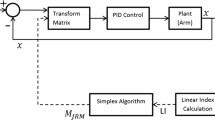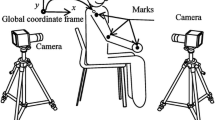Abstract
There is a no unique relationship between the trajectory of the hand, represented in cartesian or extrinsic space, and its trajectory in joint angle or intrinsic space in the general condition of joint redundancy. The goal of this work is to analyze the relation between planning the trajectory of a multijoint movement in these two coordinate systems. We show that the cartesian trajectory can be planned based on the task parameters (target coordinates, etc.) prior to and independently of angular trajectories. Angular time profiles are calculated from the cartesian trajectory to serve as a basis for muscle control commands. A unified differential equation that allows planning trajectories in cartesian and angular spaces simultaneously is proposed. Due to joint redundancy, each cartesian trajectory corresponds to a family of angular trajectories which can account for the substantial variability of the latter. A set of strategies for multijoint motor control following from this model is considered; one of them coincides with the frog wiping reflex model and resolves the kinematic inverse problem without inversion. The model trajectories exhibit certain properties observed in human multijoint reaching movements such as movement equifinality, straight end-point paths, bell-shaped tangential velocity profiles, speed-sensitive and speed-insensitive movement strategies, peculiarities of the response to double-step targets, and variations of angular trajectory without variations of the limb end-point trajectory in cartesian space. In humans, those properties are almost independent of limb configuration, target location, movement duration, and load. In the model, these properties are invariant to an affine transform of cartesian space. This implies that these properties are not a special goal of the motor control system but emerge from movement kinematics that reflect limb geometry, dynamics, and elementary principles of motor control used in planning. All the results are given analytically and, in order to compare the model with experimental results, by computer simulations.
Similar content being viewed by others
References
Abend W, Bizzi E, Morasso P (1982) Human arm trajectory formation. Brain 105:331–348
Albert A (1972) Regression and the Moor-Penrose pseudoinverse. Boston University. Academic Press, New York
Arbib MA (1981) Perceptual structures and distributed motor control. In: Brooks VB (eds) Handbook of physiology, Sect 1. The nervous system, Vol 2. Motor control. American Physiological Society, Bethesda, pp 1449–1480
Atkeson CG (1989) Learning arm kinematics and dynamics. Annu Rev Neurosci 12:157–183
Atkeson CG, Hollerbach JM (1985) Kinematic features of unrestrained vertical arm movements. J Neurosci 5:2318–2330
Baker DR, Wampler CW (1988) On the inverse kinematics of redundant manipulators. Int. J Robotics Res 7:3–21
Bellman R (1960) Introduction to matrix analysis. McGraw-Hill, New York
Berkinblit MB, Feldman AG, Fukson OI (1986a) Adaptability of innate motor patterns and motor control mechanisms. Behav Brain Sci 9:585–638
Berkinblit MB, Gelfand IM, Feldman AG (1986b) A model for the control of multijoint movements. Biophizika 31:128–138
Berkinblit MB, Gelfand IM, Feldman AG (1986c) A model for the aiming phase of the wiping reflex. In: Grillner S, Stein PSG, Stuart D, Forssberg H, Herman RM (eds) Neurobiology of vertebrate locomotion. Wenner-Gren International Symposium Series 45:217–227
Bernstein NA (1935) The problem of interrelation between coordination and localization (in Russian). Arch Biol Sci 38:1–35
Bernstein NA (1967) The co-ordination and regulation of movements. Pergamon Press, Oxford
Bizzi E, Polit A, Morasso P (1976) Mechanisms underlying achievement of final head position. J Neurophysiol 39:435–444
Bullock D, Grossberg S (1988) Neural dynamics of planned arm movements: emergent invariants and speed-accuracy properties during trajectory formation. Psychol Rev 95:49–90
Cole KJ, Abbs JH (1986) Coordination of three-joint digit movements for rapid finger-thumb grasp. J Neurophysiol 55:101–119
Corcos DM, Gottlieb GL, Agarwal GC (1989) Organizing principles for single joint movements. II. A speed-sensitive strategy. J Neurophysiol 62:358–368
Corcos DM, Gutman SR, Agarwal GC, Gottlieb GL (1990) Movement strategies and the necessity for task differentiation. Behav Brain Sci 14:359–364
Cruse H, Wischmeyer E, Bruer M, Brockfield M, Dress A (1990) On the cost functions for the control of the human arm movement. Biol Cybern 62:519–528
Cruse H, Bruer M, Dean J (1993) Control of three- and four-joint arm movement: strategy for a manipulator with redundant degrees of freedom. J Motor Behav 25:131–139
Feldman AG (1986) Once more on the equilibrium hypothesis (λ-model) for motor control. J Motor Behav 18:17–54
Feldman AG, Adamovich SV, Ostry DJ, Flanagan JR (1990) The origin of electromyograms-explanations based on the equilibrium point hypothesis. In: Winters JM, Woo SL-Y (eds) Multiple muscle systems. Springer, Berlin Heidelberg New York, pp 195–312
Fitts PM (1954) The information capacity of the human motor system in controlling the amplitude of movements. J Exp Psychol 47:103–112
Flanagan JR, Ostry DJ, Feldman AG (1993) Control of trajectory modifications in target-directed reaching. J Motor Behav 25:140–152
Flash T (1987) The control of hand equilibrium trajectories in multijoint arm movements. Biol Cybern 57:257–274
Flash T (1989) Speed-insensitive and speed-sensitive strategies in miltijoint movements. Behav Brain Sci 2:215–216
Flash T (1990) The organization of human arm trajectory control. In: Winter JM, Woo SL-Y (eds) Multiple muscle systems. Biomechanics and movement organization. Springer, New York, 282–301
Flash T, Henis E (1992) Arm trajectory modification during reaching toward visual targets. J Cogn Neurosci 3:220–230
Flash T, Hogan N (1985) The coordination of arm movements: an experimentally confirmed mathematical model. J Neurosci 5:1688–1703
Georgopulos AP, Kalaska JF, Massey JT (1981) Spatial trajectories and reaction times of aimed movements: effects of practice, uncertainty, and change in target location. J Neurophysiol 46:725–743
Goodman SR (1995) Inverse kinematic problem: solutions by pseudo-inversion, inversion, and no-inversion, Behav Brain Sci (in press)
Gottlieb DH (1986) Topology and robots. Proc IEEE Int Conf on Robotic and Automation 3:1689–1691
Gottlieb GL, Corcos DM, Agarwal GC (1989a) Strategies for the control of voluntary movements with one mechanical degree of freedom. Behav Brain Sci 12:189–210
Gottlieb GL, Corcos DM, Agarwal GC (1989b) Organizing principles for single joint movements. I. A speed-insensitive strategy. J Neurophysiol 63:342–357
Granit R (1985) Comments on time in action and perception. Hum Neurobiol 4:61–62
Green PH (1972) Problems of organization of motor system. In: Rosen R, Shell FM (eds) Progress in theoretical biology Vol 2. Academic Press, New York, 303–338
Gutman SR, Gottlieb GL (1992a) Virtual trajectory as a solution of the inverse dynamic problem. Behav Brain Sci 15:752–754
Gutman SR, Gottlieb GL (1992b) Basic functions of variability of simple pre-planned movements. Biol Cybern 68:63–73
Gutman SR, Gottlieb G, Corcos D (1990) Exponential model of a reaching movement trajectory with nonlinear time. Comment Theor Biol 2:357–383
Gutman SR, Latash ML, Almeida GL, Gottlieb GL (1993) Kinematic description of variability of fast movements: analytical and experimental approaches. Biol Cybern 69:485–492
Hasan Z (1986a) Do subprograms for movements always seek equilibrium? Behav Brain Sci 9:609–610
Hasan Z (1986b) Optimized movement trajectories and joint stiffness in unperturbed, inertially loaded movements. Biol Cybern 53:373–382
Henis E, Flash T (1989) Mechanisms subserving arm trajectory modification. Perception 18:495
Herrick CL (1898) Physiological corollaries of the equilibrium theory of nervous action and control. J Comp Neurol February: 21–31
Hogan N (1985) The mechanics of multi-joint posture and movement. Biol Cybern 52:315–331
Hogan N, Winters JM (1990) Principles underlying movement organization: upper limb. In: Winters JM, Woo SL-Y (eds) Multiple muscle systems. Springer Berlin Heidelberg, New York
Hollerbach JM, Atkinson CG (1987) Deducing planning variables from experimental arm trajectories: pitfalls and possibilities. Biol Cybern 56:279–292
Hollerbach JM, Flash T (1982) Dynamic interactions between limb segments during planar arm movements. Biol Cybern 44:67–77
Hong D, Corcos DM, Gottlieb GL (1994) Task patterns of muscle activation at the shoulder and elbow for unconstrained arm movements. J Neurophysiol 71:
Klein CA, Huang CH (1983) Review of pseudo inverse control for use with kinematically redundant manipulators. IEEE Trans Syst Man Cybern SMC 13:245–250
Knatib O (1985) Real-time obstacle avoidance for manipulators and mobile robots. Proc Int Conf Rob Autom, pp 500–505
Krueger LE (1989) Reconciling Fechner and Stevens: toward a unified psychophysical law. Behav Brain Sci 12:251
Latash ML (1993) Control of human movement. Human Kinetics Publisher, Champaign
Latash ML, Gutman SR (1993) Variability of fast single joint movements and the equilibrium point hypothesis. In: Newell K, Corcos D (eds) Variability in motor control. Human Kinetics, Urbana, pp 157–182
Liegeois A (1977) Automatic supervisory control of the configuration and behavior of multibody mechanisms. IEEE Trans Syst Man Cybern SMC-7:868–870
Martin DP, Baillieul J, Hollerbach JM (1989) Resolution of kinematic redundancy using optimization technique. IEEE Trans Rob Autom 5:529–533
Massey JT, Lurito JT, Pellizzer G, Georgopoulos AP (1992) Three-dimensional drawings in isometric conditions: relation between geometry and kinematics. Exp Brain Res 88:685–690
Meijer OG, Wagenaar RC, Blankendaal FCM (1988) The hierarchy debate: tema con variazioni. In: Meijer OG, Roth K (eds) Complex movement behaviour: ‘the’ motor-action controversy, Elsevier Science (North-Holland), Amsterdam pp 489–561
Meulen van der JHP, Gooskens RHJM, Denier van der Gon JJ, Gielen CCAM, Wilhelm K (1990) Mechanisms underlying accuracy in fast goal-directed arm movements in man. J Mot Behav 22:67–84
Morasso P (1981) Spatial control of arm movements. Exp Brain Res 42:223–227
Morasso P (1983) Three-dimensional arm trajectories. Biol Cybern 48:187–194
Mussa-Ivaldi FA, Morasso P, Zaccaria R (1988) Kinematic networks. A distributed model for representing and regularizing motor redundancy. Biol Cybern 60:1–16
Nagasaki H (1989) Asymmetric velocity and acceleration profiles of human arm movements. Exp Brain Res 74:319–326
Nakamura Y, Nanafusa H, Yoshikawa T (1987) Task-priority based redundancy control of robot manipulators. Int J Rob Res 6:3–15
Nelson WL (1983) Physical principles for economies of skilled movements. Biol Cybern 46:135–147
Plamondon R, Alimi AM, Yergeau P, Leclerc F (1993) Modeling velocity profiles of rapid movements: a comparative study. Biol Cybern 69:119–128
Soechting JF, Flanders M (1992) Moving in three-dimensional space: frames of reference, vectors and coordinate systems. Annu Rev Neurosci 15:167
Soechting JF, Lacquaniti F (1981) Invariant characteristics of a pointing movement in man. J Neurosci 1:710–720
Soechting JF, Terzuolo SA (1987) Organization of arm movements. Wrist motion is piecewise planar. Neuroscience 23:53–61
Stein RB, Oguztoreli MN, Capaday C (1986) What is optimized in muscular movements? In: Jones NL, McMartney N, McComas AJ (eds) Human muscle power. Human Kinetics, Champaign, 131–150
Turvey MT (1977) Preliminaries to a theory of action with reference to vision. In: Show N, Bransford J (eds) Perceiving, acting, and knowing: toward an ecological psychology. Erlbaum, Hillsdale
Turvey MT (1990) The challenge of a physical account of action: a personal view. In: Whiting HTA, Meijer OG, Van Wieringen PCW (eds) The natural-physical approach to movement control. VU University Press, Amsterdam pp 58–92
Viviani P, Terzuolo C (1980) Space-time invariance in learned motor skill. In: Stelmach GE, Requin J (eds) Tutorial motor behav. North-Holland, Amsterdam, pp 525–533
Whiting HTA (1984) Human motor actions: Bernstein reassessed. Elsevier, Amsterdam
Whitney DE (1969) Resolved motion rate control of manipulators and human prostheses. IEEE Trans Man Machine Syst MMS-10:47–53
Whitney DE (1972) The mathematics of coordinated control of prosthetic arms and manipulators. J Dyn Syst Meas Control. December: 303–309
Yoshikawa T (1985) Manipulability of robotic mechanisms. Int J Rob Res 4:3–9
Author information
Authors and Affiliations
Rights and permissions
About this article
Cite this article
Goodman, S.R., Gottlieb, G.L. Analysis of kinematic invariances of multijoint reaching movement. Biol. Cybern. 73, 311–322 (1995). https://doi.org/10.1007/BF00199467
Received:
Accepted:
Issue Date:
DOI: https://doi.org/10.1007/BF00199467




